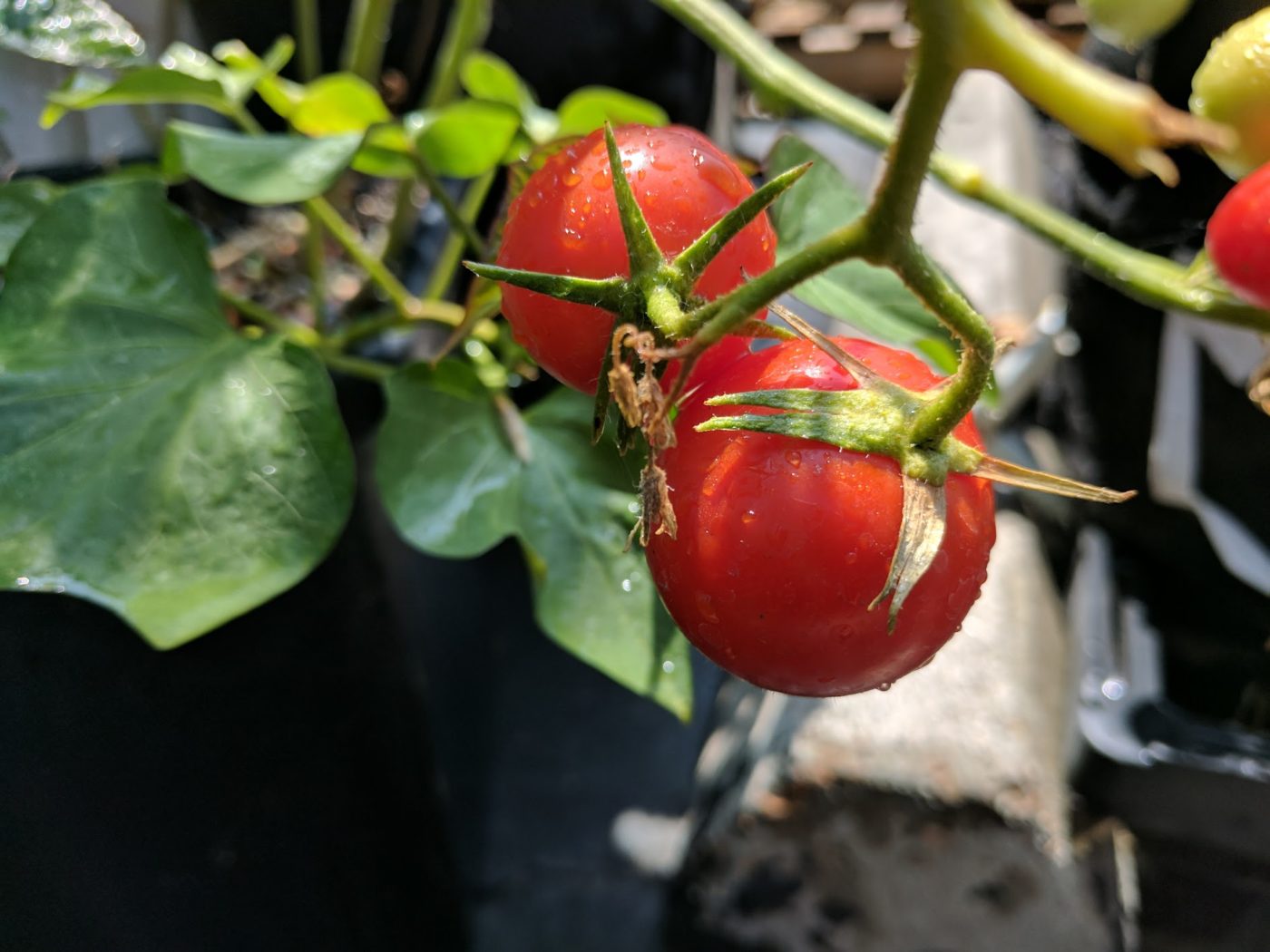Many tomato growers have found great success using 247Garden grow bags, and their experiences offer helpful tips for others. Here’s a summary of what they shared:
- Size Matters: For indeterminate tomatoes, 15-25 gallon grow bags work best, offering enough room for roots and reducing the need for frequent watering. Smaller determinate and dwarf varieties do well in 5-10 gallon bags. Cherry tomatoes thrive in 7-10 gallon bags, but larger sizes improve growth potential and yield.
- Frequent Watering: Grow bags dry out faster than plastic containers due to their porous nature. To combat this, many growers set up drip irrigation systems or place bags in shallow water trays to help maintain moisture levels. Some even add mulch around and on top of the bags to retain water.
- Fertilization: Because grow bags need more frequent watering, nutrients are washed away faster. Growers recommend using slow-release fertilizers or supplementing regularly with organic options like fish emulsion or worm castings to keep plants healthy.
- Companion Planting: Many gardeners successfully grow herbs like basil, thyme, and sage alongside tomatoes in the same grow bag, especially in larger bags (7-gallon or more).
- Climate Considerations: In dry, hot climates, adding soil amendments like vermiculite and using straw mulch on top of the soil helps retain moisture. Lighter-colored bags (like tan) prevent the soil from overheating, particularly in intense sun.
- Conclusion: Grow bags are versatile and work well in a variety of environments, especially when space is limited. While they require more attentive watering and fertilizing, their success rate is high, making them a favorite among patio gardeners and those with limited garden space.
For 247Garden, promoting grow bags ranging from 5 to 25 gallons depending on tomato types—along with advice on irrigation and fertilization—could greatly benefit customers growing tomatoes in different climates.
Related Products
-
 247Garden 7-Gallon Aeration Fabric Pot/Plant Grow Bag w/Handles (Black 12H x 13D)Rating:100%$1.49 As low as $1.3623588 in stock
247Garden 7-Gallon Aeration Fabric Pot/Plant Grow Bag w/Handles (Black 12H x 13D)Rating:100%$1.49 As low as $1.3623588 in stock -
 247Garden 15-Gallon Aeration Fabric Pot/Plant Grow Bag w/Handles (Black 14.5H x 17D)Rating:100%$2.68 As low as $2.54146771 in stock
247Garden 15-Gallon Aeration Fabric Pot/Plant Grow Bag w/Handles (Black 14.5H x 17D)Rating:100%$2.68 As low as $2.54146771 in stock -
 247Garden 7-Gallon Short Aeration Fabric Pot/Vegetable Grow Bag w/Handles (Black 9H x 15D)Rating:100%$1.78 As low as $1.6874 in stock
247Garden 7-Gallon Short Aeration Fabric Pot/Vegetable Grow Bag w/Handles (Black 9H x 15D)Rating:100%$1.78 As low as $1.6874 in stock -
 247Garden 15-Gallon Short Aeration Fabric Pot/Vegetable Grow Bag w/Handles (Black 12H x 19D)Rating:100%$2.98 As low as $2.780 in stockOut of stock
247Garden 15-Gallon Short Aeration Fabric Pot/Vegetable Grow Bag w/Handles (Black 12H x 19D)Rating:100%$2.98 As low as $2.780 in stockOut of stock -
 247Garden 5-Gallon Aeration Fabric Pot/Plant Grow Bag w/Handles (Tan w/Black Base 10H x 12D)Rating:100%$1.58 As low as $1.480 in stockOut of stock
247Garden 5-Gallon Aeration Fabric Pot/Plant Grow Bag w/Handles (Tan w/Black Base 10H x 12D)Rating:100%$1.58 As low as $1.480 in stockOut of stock -
 247Garden 10-Gallon Aeration Fabric Pot/Plant Grow Bag w/Handles (Tan w/Black Base 13H x 15D)Rating:100%$2.45 As low as $2.35318 in stock
247Garden 10-Gallon Aeration Fabric Pot/Plant Grow Bag w/Handles (Tan w/Black Base 13H x 15D)Rating:100%$2.45 As low as $2.35318 in stock -
 247Garden 5-Gallon Aeration Fabric Pot/Planting Grow Bag w/Handles (White 10H x 12D)$1.58 As low as $1.480 in stockOut of stock
247Garden 5-Gallon Aeration Fabric Pot/Planting Grow Bag w/Handles (White 10H x 12D)$1.58 As low as $1.480 in stockOut of stock -
 247Garden 7-Gallon Aeration Fabric Pot/Planting Grow Bag w/Handles (White 12H x 13D)$1.88 As low as $1.740 in stockOut of stock
247Garden 7-Gallon Aeration Fabric Pot/Planting Grow Bag w/Handles (White 12H x 13D)$1.88 As low as $1.740 in stockOut of stock -
 247Garden 10-Gallon Aeration Fabric Pot/Planting Grow Bag w/Handles (White 13H x 15D)$2.45 As low as $2.280 in stockOut of stock
247Garden 10-Gallon Aeration Fabric Pot/Planting Grow Bag w/Handles (White 13H x 15D)$2.45 As low as $2.280 in stockOut of stock -
 247Garden 20-Gallon Square Aeration Fabric Pot Planting Grow Bag w/Handles Black 18 x 18 x 14.5$3.48 As low as $3.190 in stockOut of stock
247Garden 20-Gallon Square Aeration Fabric Pot Planting Grow Bag w/Handles Black 18 x 18 x 14.5$3.48 As low as $3.190 in stockOut of stock -
 247Garden 5X60FT All-Season Trellis Netting w/ 5in Square Mesh (White, Nylon Gardening Net 300 Sqft)$7.99 As low as $6.990 in stockOut of stock
247Garden 5X60FT All-Season Trellis Netting w/ 5in Square Mesh (White, Nylon Gardening Net 300 Sqft)$7.99 As low as $6.990 in stockOut of stock -
 247Garden 7-Gallon Black Planters Grow Bags Aeration Fabric Pots w/Handles (12H x 13D) 5-PackRating:80%$15.95Free USA Shipping
247Garden 7-Gallon Black Planters Grow Bags Aeration Fabric Pots w/Handles (12H x 13D) 5-PackRating:80%$15.95Free USA Shipping -
 247Garden 6X200FT All-Season Trellis Netting w/ 6in Square Mesh (White, Nylon Gardening Net 1200 Sqft Spool Roll)Rating:100%$19.271039 in stock
247Garden 6X200FT All-Season Trellis Netting w/ 6in Square Mesh (White, Nylon Gardening Net 1200 Sqft Spool Roll)Rating:100%$19.271039 in stock -
 247Garden 6X300FT All-Season Trellis Netting w/ 3 in Square Mesh (White, Nylon Gardening Net 1800 Sqft Spool Roll)$37.220 in stockOut of stock
247Garden 6X300FT All-Season Trellis Netting w/ 3 in Square Mesh (White, Nylon Gardening Net 1800 Sqft Spool Roll)$37.220 in stockOut of stock -
 247Garden 6X200FT All-Season Trellis Netting w/ 3 in Square Mesh (White, Nylon Gardening Net 1200 Sqft Spool Roll)$29.880 in stockOut of stock
247Garden 6X200FT All-Season Trellis Netting w/ 3 in Square Mesh (White, Nylon Gardening Net 1200 Sqft Spool Roll)$29.880 in stockOut of stock -
 247Garden 5X200FT All-Season Trellis Netting w/ 6in Square Mesh (White, Nylon Gardening Net 1000 Sqft Spool Roll)$16.700 in stockOut of stock
247Garden 5X200FT All-Season Trellis Netting w/ 6in Square Mesh (White, Nylon Gardening Net 1000 Sqft Spool Roll)$16.700 in stockOut of stock -
 247Garden 5X200FT Garden+Plant Trellis Netting w/ 6in Square Mesh$20.95Free USA ShippingOut of stock
247Garden 5X200FT Garden+Plant Trellis Netting w/ 6in Square Mesh$20.95Free USA ShippingOut of stock
































